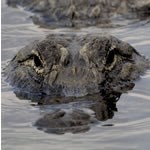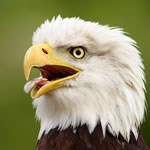
NPS/EVER Alligators of Arkansas PostOnce prized for its valuable hide, the American Alligator (Alligator mississippiensis) was nearly hunted to extinction. Fortunately, alligator populations in Arkansas have increased following twenty years of protection under the Federal Endangered Species Act. The waters of Arkansas Post National Memorial provide valuable habitat to over a dozen alligators, some of which are fourteen feet in length. What Do Alligators Eat?Alligators will eat just about anything that gets close enough. Soon after alligators emerge from their eggs they begin to look for food. Young gators normally eat insects, snails, frogs, and small fish. As the gator grows, it adds larger animals to the menu. “What big claws you have ...”Female alligators normally lay between 25 and 60 eggs in late Spring. An alligator uses its large claws to dig a nest where the eggs will incubate for 2 - 3 months. While she is waiting for the eggs to hatch, the mother stays near the nest to protect it. Once the eggs hatch, she will continue to protect her young until they become large enough to protect themselves from predators such as birds, racoons, and large fish. Look-alikesThe American Alligator is often confused with its cousin the American Crocodile. If you look closely (but not too close!) you can see that the crocodile’s snout is pointed. The alligator has a rounded or “bulbous” snout. Another clue to telling them apart is to look at the tail. A crocodile’s tail has pointed ridges that are larger than those of the alligator. There are no crocodiles in Arkansas, although they are making a come-back in Southern Florida. Gator Safety Tips

Jason Crader Bald Eagles of Post BayouIn 1782, the founding fathers chose the Bald Eagle as our National Symbol because it symbolized strength, courage, freedom and a long life. Bald eagles once numbered an estimated half a million in North America. However, by 1963, the species was on the brink of extinction with fewer than seven hundred Bald Eagles remaining. Through the efforts of law-makers and concerned citizens, bald eagles are now protected and the species is making a come-back.With a wing-span reaching over seven feet, the Bald Eagle is the largest Raptor (hawks and eagles) found in North America. This large wing span gives the bald eagle tremendous lifting ability, allowing it to lift and carry up to five pounds. The bald eagle has white feathers on it’s head, neck and tail. The word “Bald” is taken from an Old English term meaning white. Bald eagles do not get their white feathers until they reach maturity, usually around four to five years of age. Until that point, the immature bald eagle is covered in brown feathers. The bald eagle uses it’s superb eyesight to locate fish swimming near the surface of the water. Once it spots a potential meal, the eagle swoops down and grabs the fish in it’s powerful talons. |
Last updated: December 27, 2022
